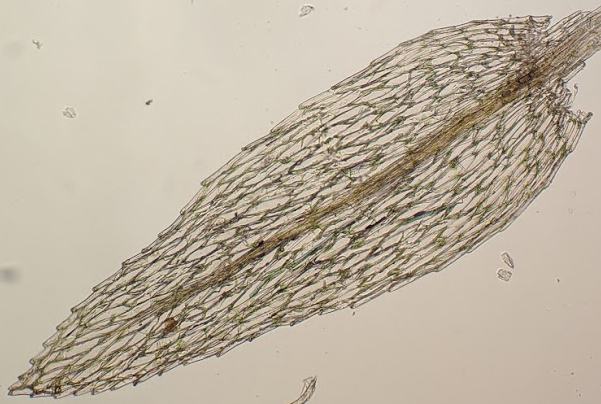Mniaceae
Dioicous, autoicous (not in Victoria), paroicous, synoicous or polyoicous (not in Victoria). Asexual reproduction by flagelliform branches (not in Victoria), rhizoidal tubers (not in Victoria) or filiform or bulbiform gemmae in leaf axils (not in Victoria). Mats, tufts or turves on rocks, soil or rarely trees (not in Victoria). Stems erect, arching or creeping, simple, irregularly forking, rarely more frequently branched toward stem apex (not in Victoria), with rhizoids near base or with tomentum on ventral side of creeping stems; rhizoids often dimorphic; central strand present. Leaves arranged around the stem and facing all directions, distichous or complanate (not in Victoria), monomorphic, dimorphic with dorsal leaves smaller than lateral leaves (not in Victoria) or larger toward stem apex, sometimes more crowded near stem apices, erect to widely-spreading when moist, contorted, twisted or imbricate when dry; apex obtuse, mucronate, acute or acuminate, without a hair-point; costa ending in the apical half, percurrent or rarely short-excurrent; margin entire or serrulate to serrate, plane, undulate or revolute, with a border of more elongate cells or without a border; laminal cells rounded-quadrate, rounded- or elongate-hexagonal, rhomboid to linear-rhomboidal, becoming oblong to rectangular toward base, smooth or mammillose (not in Victoria); alar cells not differentiated. Acrocarpous. Capsules erect to pendent, symmetric, exserted, operculate, with well differentiated neck, sometimes as long or longer than urn, annulus present or absent. Calyptrae cucullate, smooth, naked. Operculum convex, conic, conic-apiculate or rostrate. Peristome double and alternate, single or reduced; exostome of 16 entire teeth, reduced or absent; endostome of 16 segments, with a low to high basal membrane or reduced to a rudimentary membrane (not in Victoria) or absent (not in Victoria); cilia present or absent.
Around 13 genera and 240 species, but Pohlia in need of revision that would result in it being split into several genera (Guerra et al. 2011; Niu et al. 2018; see Pohlia profile); three genera and seven species in Victoria.
The family Mielichhoferiaceae, that has included the Victorian genera Pohlia and Mielichhoferia, is often recognised (e.g. Shaw 2014; Shaw & Ramsay 2013) and has also been included within the Bryaceae (e.g. Brotherus 1925; Zhang et al. 2007), but here is included within the Mniaceae. This broader circumscription of Mniaceae introduced by Goffinet & Buck (2004) is in response to phylogenetic analyses of chloroplast and nuclear DNA sequences that show that the genera of Mielichhoferiaceae group together with the genera of the traditional Mniaceae and that some Mielichhoferiacreae taxa may be more closely related to traditional Mniaceae taxa than they are to other Mielichhoferiaceae (Cox & Hedderson 1999; Guerra et al. 2011; Niu et al. 2018).
 Spinning
SpinningBrotherus, V.F. (1925). Musci (Laubmoos), in Engler, A. (ed.), Die natürlichen Pflanzenfamilien, edition 2. Bd 11. Engelmann, Leipzig.
Goffinet, B.; Buck, W. R. (2004). Systematics of the Bryophyta (Mosses): from Molecules to a Revised Classification. Monographs in Systematic Botany from the Missouri Botanical Garden 98: 205–239.
Guerra, J.; Jiménez-Martínez, J.F.; Cano, M.J.; Jiménez-Fernández, J.A. (2011). A contribution to the phylogenetic study of Mielichhoferiaceae-Mniaceae (Bryophyta) based on molecular sequence data. Nova Hedwigia 93: 47–56.
Niu, J.-Y.; Li, L.; Shi, S.; Li, H.; Wang, X.-R.; Liu, Y.-Y.; Niu, Y.-L.; Zhao, J.-C. (2018). Phylogenetic analysis of the genus Pohlia (Bryophyta, Bryaceae) using chloroplast and nuclear ribosomal DNA. *Phytotaxa * 351: 141–153.
Shaw, A.J. (2014). Mielichhoferiaceae, in Flora of North America Editorial Committee (eds), Flora of North America, vol. 28: Bryophyta, part 2, pp. 189–214. Oxford University Press, New York.
Shaw, A.J.; Ramsay, H.P. (2013). Australian Mosses Online. 69. Mielichhoferiaceae. www.anbg.gov.au/abrs/Mosses_online/Mielichhoferiaceae.pdf. ABRS, Canberra.
Zhang, D.-C.; Li, X.-J.; He, S. (2007). Bryaceae, in Li, X.-J., Crosby, M.R. & He, S. (eds), Moss Flora of China 4. Bryaceae–Timmiaceae, pp. 3–92. Science Press and Missouri Botanical Garden, Beijing and New York, and St. Louis.



